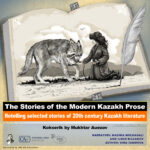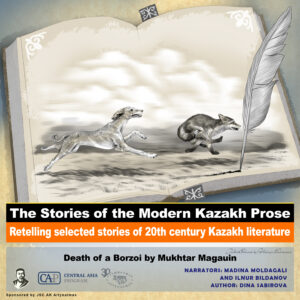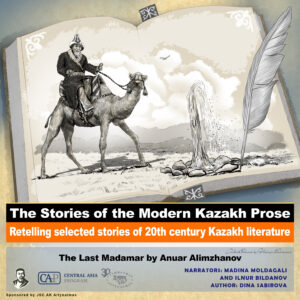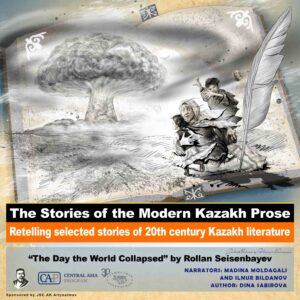
Mukhtar Auezov (September 28, 1897–June 27, 1961) was a prominent Kazakh writer and an honored academic of the Soviet Union. Auezov’s works had a major influence on the development of Kazakh literature. He wrote numerous essays, short stories, and plays (many of which have been translated into other languages) in different genres, but his greatest literary work was an epic entitled The Way of Abai. The latter brought him the prestigious Lenin Prize in 1958. In this episode, we want to retell one of his lesser-known works: Kokserek, a story about a fierce gray wolf. The story became the basis of the 1974 Soviet drama film of the same name directed by Tolomush Okeyev, which was selected as the Soviet entry for Best Foreign Language Film at the 47th Academy Awards.
Full text
A couple of wolves settled in the Black Ravine, from which trouble often came. The she-wolf gave birth to seven cubs. She spent her days in the sun, while the male wolf would hunt. He would bring delicious prey, such as a lamb that was still alive, to feed her and the cubs.
One sunny day, the she-wolf heard the sound of horses’ galloping hooves. Pushing the cubs into the hole, she fled. However, the horses’ riders dragged five wolf cubs out of the hole, killing four of them and breaking the legs of the fifth. They took the youngest wolf cub with them.
The humans believed that the wolves would leave the area to save the remaining cub. And indeed, the she-wolf approached the remaining wolf cub, took him by the neck, and ran away.
The youngest wolf cub became a pet of a little boy called Kurmash. People believed that a blind wolf cub could be brought out as a dog. Two days later, the cub opened his eyes but was afraid to leave the house; he could not tolerate the smell of dogs. The child slept with the wolf cub.
By the middle of summer, the wolf cub had grown up. They named him Kokserek. He was no different from the village puppies, but the dogs did not accept him. Nor did Kurmash’s grandmother. For the wolf cub, life in the village seemed like bondage. It was stuffy in the house. He was always hungry. Everyone in the village was surprised by the voracity of his appetite. Even though Kurmash loved him and fed him well, Kokserek devoured everything. Sometimes he even stole boiled meat—for which they beat him mercilessly. But he was proud: he never cried out when he was beaten, but simply glared at people.
One day the villagers pitted Kokserek against a black dog. The fight would have ended in the death of the black dog, but the adults stopped the fight. The village dogs stopped barking at him. Kokserek outgrew them all. He never wagged his tail.
The village was attacked by wolves. People gathered to drive them away but failed to catch them. Kokserek took part in the chase and returned later. But a while later Kokserek disappeared for three days. When he returned, he had changed; he had became haggard. Kurmash’s grandmother fed him. Kurmash’s father offered to kill the wolf for his skin. As if hearing what they were saying about him, the wolf ran away.
All winter, the wolf hunted hares. But by the end of winter there was no game left. Kokserek began to return to the village more often.
That winter, Kokserek met a white she-wolf; they liked each other. Together, they attacked the village. They were chased out. Leading the chase was a black piebald dog. When the rest of the pack fell behind, the white she-wolf attacked the dog and they ate it.
Everyone in the neighboring villages started to talk about the insatiable, fierce gray wolf who was not afraid of people. Kokserek and the white she-wolf stuck together. They ruthlessly brought down sheep and camels. And it seemed that Kokserek could not get enough of the blood. Only in the spring did he calm down.
Once, returning to his lair, Kokserek smelled a new, unfamiliar scent. It was the white she-wolf’s brood. Kokserek ran up to one wolf cub, pulled it out of the lair with his teeth, and pummeled it into the ground until it became a gray lump, then threw it over itself in disgust. The she-wolf managed to save the rest of the cubs. Later, the she-wolf resumed hunting with him. But she was of little use. She was overweight and clumsy.
A few days later, they sensed the presence of a human. Returning to the lair, they saw that only one wolf cub with broken paws remained. Young people galloped up next, intending to capture Kokserek and the white she-wolf. The white wolf was clumsy. She lagged behind Kokserek and soon he lost sight of her. When he returned to the place of the chase, he found a pool of blood and realized that the humans had killed her.
Ruthlessly, Kokserek began to hunt for foals. Over the summer, he grew fat. One night, Kokserek met a pack of wolves. He was much younger than the leader, but stronger and bigger. All the wolves understood that this was not the enemy, but rather the owner of these places. For several days they hunted together, but on the next hunt Kokserek killed the leader of the pack, becoming the leader himself.
Once, they even attacked a man. It was unseen to attack people. The pack watched expectantly to see what the leader would do. Suddenly, other people rode closer, drove away the wolves, and saved the man.
Another time, Kokserek saw a strangely slow traveler on a camel. He decided to attack. He ran fearlessly toward the traveler, but the traveler pulled out a black stick. A sound like a thunderclap rang out—and a kind of steel wasp bit Kokserek, causing him such piercing pain that he yelped from pain for the first time. There were drops of blood on the snow. Kokserek fled to his lair. Fortunately, the pack did not see a drop of blood, or they would have Kokserek. It took three days for the flow of blood to stanch. In that time, Kokserek lost weight and grew weak. Fortunately, he came across a young mare with a foal; he ate the foal all night.
A few more days passed, and Kokserek’s leg began to hurt less. He was drawn to the Black Ravine, to the places where he had grown up. Once, drawing close to the village, he saw a herd of sheep. Abruptly jumping out of the bush, he wanted to attack. However, the teenage shepherd screamed—and there was something familiar in his voice. The boy cried, “Kokserek, Kokserek.” He threw a stick at Kokserik and hit his wounded leg. Full of anger, Kokserek tore up the stick and attacked the teenager. The only thing the boy saw before his death was Kokserek’s familiar torn ears.
It was sad for everyone in the village. Khasen, a hunter and distant relative of Kurmash, was especially bitter. Kurmash’s father asked at his son’s grave that Khasen find Kokserek and kill him. Khasen had a dog, Akkaska, who was famous throughout the region. Together, they plotted to ambush Kokserek.
Kokserek gave a short yelp and attacked. The dog and the wolf clashed again. Fangs sparked like stars on a dark night. And then Akkaska, not being careful, but remembering only what the man was shouting, stuck his nose right into the wolf’s mouth and grabbed the beast tightly by the lower jaw. Now they could not be disengaged: the dog gnawed at the wolf’s jaw, the wolf bit the dog, and neither could knock down the other. Khasen rode closer. His horse danced under him, rearing up. Khasen’s hands danced too. He threw the gun, jumped out of the saddle, and, without thinking about himself, fell with his whole body on the rock-hard back of the wolf. He thrust a wide knife under the wolf’s shoulder-blade. Akkaska removed his torn muzzle from the wolf’s bared mouth and stepped back—stepped back, stood for a moment, and fell on his chest. Opposite him lay Gray the Fierce on his side. The hunters began to drive up, and one of them poked the wolf in the teeth with a whip, opening its black-and-red mouth. Everyone was amazed at how big the wolf was. “The devil!” said one, moving away. “Kokserek!” Khasen said, carefully examining Akkaska’s wounds. The wolf’s carcass was brought to the village and thrown into Kurmash’s yurt, where the old grandmother recognized Gray the Fierce by his torn ear. “Kokserek!” cried the old grandmother, wringing her hands. “Thrice damned… Where is your conscience? Bloodsucker!” And with a weak foot she kicked the wolf in his bared mouth.
*
Many researchers believe that Kokserek was influenced by Jack London’s White Fang. But wolves and animals feature regularly in great Central Asian stories, most notably those of Chingiz Aitmatov. Auezov’s story is simultaneously realistic and symbolic. Kokserek was a gray wolf whom humans tried to domesticate. But the wolf could not be tamed, just as nature, in general, cannot. The rules cannot be altered and enemies cannot be friends. If a man breaks the legs of wolf pups in the hope of protecting his sheep, a wolf is capable of inflicting the same grief on the man and his children. An animal is driven by its instincts, which Auezov presents realistically. Wild nature is beautiful and cruel, and man must adapt to it, not alter it.




